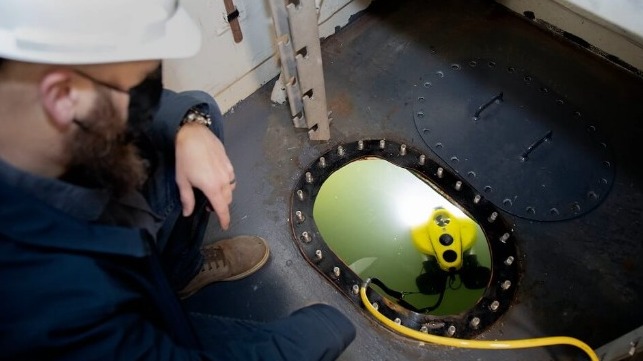U.S. Navy Tests Out Mini-ROV for Inspecting Ballast Tanks

The U.S. Navy is testing out the use of small remotely operated vehicles (ROVs) to carry out ballast tank inspections without first draining the tanks. If successful, the technology could help reduce the lead time and cost of shipyard maintenance, a key priority for the service.
On Feb. 16, a team from Puget Sound Naval Shipyard demonstrated the use of a VideoRay Pro 4 ROV for inspecting ballast tanks, using the amphibious assault ship USS Iwo Jima as a test site. The yard has been using the ROV for nuclear tank and void inspections for several years now, and with its success, the Navy is looking at the possibility of broadening its use at regional maintenance centers and other maintenance facilities.
Aboard Iwo Jima at the Mid-Atlantic Regional Maintenance Center, 20 personnel from Puget Sound Naval Shipyard, Southeast Regional Maintenance Center, Southwest Regional Maintenance Center and other facilities watched as the ROV navigated its way around the tank.
“We were able to get a pretty clear and accurate view of inside of the tank,” said Ty Curtin, Mid-Atlantic Regional Maintenance Center's Tanks, Voids and Structural Branch Head. “We could see a lot of items in this tank that were documented previously by our assessors. When the ship enters its availability this summer, we can go in and compare what we saw today.”
Tank inspections and overhauls are conducted often during maintenance availabilities. The process of emptying a tank, drying it out and conducting a gas-free assessment requires a lot of time, money and man-hours.
“There’s an entire process we have to go through before we could get someone into a tank to conduct an inspection that most times takes only a couple of hours to complete,” said Kevin Baum, Mid-Atlantic Regional Maintenance Center's Ventilation and Damage Control Branch Head. “On the [destroyers and cruisers], where stability is critical, having the ability to conduct an accurate and descriptive inspection or check on a specific issue without having to go through that preliminary process could be a game changer for us.”
The use of a submersible ROV drone in a filled ballast tank is relatively unusual, but flying drone video inspections are growing in popularity across the maritime industry - particularly in the offshore sector, where they may be substituted for rope-access structural inspections. They are a subject of active R&D activity for class societies - like DNV and ABS - and for large shipowning companies, like Polar Tankers and CMA CGM.
